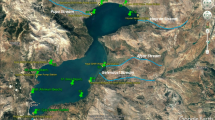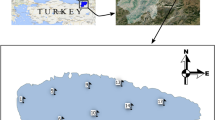Abstract
This study presents the results of the heavy metals and natural radioactivity for evaluation of the environmental pollution of Boraboy Lake as was agriculture and touristic activities area. The aim of the study is to determine the environmental and health effects of natural radioactivity levels, radiological hazards, heavy metal concentrations, and the relationship between metal concentration and some physicochemical properties (pH, conductivity, and saturation) in Boraboy Lake water, soil, and sediment. For this reason, radioactivity concentration (40K, 226Ra, and 232Th), radium equivalent activities (Raeq), absorbed dose rate (ADR), annual effective dose rate (AEDR), radiation hazard indexes (Hin, Hex), and excess lifetime cancer risk (ELCR) have been investigated in the water, soil, and sediment samples in the Boraboy Lake in Amasya, Turkey. Also, contents and concentrations of heavy metals (Cu, Cd, Fe, Mn, Ni, Pb, Zn, Cr, and Al) have been determined. All the health hazard index results have been found the world average values reported by the United Nations Scientific Committee on the Effects of Atomic Radiation (UNSCEAR) acceptable limits. The water, sediment, and soil results from the heavy metals are also found to be within limits of tolerance.







Similar content being viewed by others
References
AbdEl-mageed AI, El-Kamel AH, Abbady A, Harb S, Youssef AMM, Saleh II (2011) Assessment of natural and anthropogenic radioactivity levels in rocks and soils in the environments of Juban town in Yemen. Rad Phys Chem 80:710–715. https://doi.org/10.1016/j.radphyschem.2011.02.025
Akkurt I, Mavi B, Akyıldırım H, Günoglu K (2009) Natural radioactivity of coals and its risk assessment. International Journal of Physical Sciences 4(7):403–406
Beretka J, Matthew PJ (1985) Natural radioactivity of Australian building materials, industrial wastes and by-products. Health Phys 48(1):87–95. https://doi.org/10.1097/00004032-198501000-00007
Cliff KD, Green BMR, Miles JCH (1985) The levels of radioactive materials in some in some UK building materials. Sci Total Environ 45:181–186. https://doi.org/10.1016/0048-9697(85)90219-0
Currie LA (1968) Limits for qualitative detection and quantitative determination. Anal Chem 40:586–593. https://doi.org/10.1021/ac60259a007
Engin MS, Uyanik A, Kutbay HG (2015) Accumulation of heavymetals in water, sediments and wetland plants of Kizilirmak Delta (Samsun, Turkey). Int J Phytorem 17(1):66–75. https://doi.org/10.1080/15226514.2013.828019
EPA Method (2007) Determination of metals and trace metals in water and wastes by inductively coupled plasma atomic emission spectrometry. http://www.epa.gov/waterscience/methods/method/files/200_7.pdf. Accessed 12.07.2018
Erdoğan K, Kandemir Ş, Doğru MI, Doğru A, Şimşek I, Yılmaz S, … Örün I (2021) The effects of seasonal heavy-metal pollution of Ladik Lake on pike fish (Esox lucius). Biol Rhythm Res 52(6):821–845. https://doi.org/10.1080/09291016.2019.1607215
Hakanson L (1980) An ecological risk index for aquatic pollution control. A Sedimentological Approach Water Research 14(8):975–1001
ICRP (1990) International Commission on Radiological Protection. ICRP Publication 60, Annals of the ICRP, 21(1–3) Pergamon Press, New York
Järup L (2003) Hazards of heavy metal contamination. Br Med Bull 68(1):167–182. https://doi.org/10.1093/bmb/ldg032
Kampa M, Castanas E (2008) Human health effects of air pollution. J Env Pol 151(2):362–367. https://doi.org/10.1016/j.envpol.2007.06.012
Krieger R (1981) Radioactivity of construction materials. Betonwerk. Fertigteil-Tech 47:468
Krisiuk EM, Tarasov SI, Shamov VP, Shlak NI, Lisachenko EP, Gomslsky LG (1971) A study of radioactivity in building materials. Research Institute of Radiation Hygeine Leningrad
Mavi B (2012) Experimental investigation of γ-ray attenuation coefficients for granites. Ann Nucl Energy 44:22–25. https://doi.org/10.1016/j.anucene.2012.01.009
Mavi B, Akkurt I (2010) Natural radioactivity and radiation hazards in some building materials used in Isparta. Turkey Rad Phys Chem 79:933–937. https://doi.org/10.1016/j.radphyschem.2010.03.019
NEA–OECD (1979) Nuclear Energy Agency. Exposure to radiation from natural radioactivity in building materials. Report by NEA Group of Experts
Oresegun MO, Babalola AI (1988) Annual indoor dose burden estimates in dwellings built in Nigeria with radioactive U-Th rich tailings. Proceedings of an International Conference on Radiation Protection in Nuclear Energy 2:159–166
Otoo F, Adukpo OK, Darko EO, Emi-Reynolds G, Awudu AR, Ahiamadjie H (2012) Radiological impact of soil as a source of building material. Radiat Prot Environ 35(1):22–28
Qureshi AA, Tariq S, Din KU, Mauzoor S, Calligaris C, Waheed A (2014) Evaluation of excessive lifetime cancer risk due to natural radioactivity in the rivers sediments of Northern Pakistan. J Rad Res Appl Sci 7:438–447. https://doi.org/10.1016/j.jrras.2014.07.008
Radulescu C, Dulama ID, Stihi C, Ionita I, Chilian A, Necula C, Chelarescu ED (2014) Determination of heavy metal levels in water and therapeutic mud by atomic absorption spectrometry. Rom J Phys 59(9–10):1057–1066
Sert I, Eftelioglu M, Ozel FE (2017) Historical evolution of heavy metal pollution and recent records in Lake Karagöl sediment cores using 210 Pb models, western Turkey. J Radioanal Nucl Chem 314:2155–2169. https://doi.org/10.1007/s10967-017-5627-x
Turhan S (2008) Assessment of the natural radioactivity and radiological hazards in Turkish cement and its raw materials. J Environ Radioact 99(2):404–414. https://doi.org/10.1016/j.jenvrad.2007.11.001
UNSCEAR- United Nations Scientific Committee on the Effects of Atomic Radiation (2000) Sources, effects and risks of ionizing radiation. Report to the General Assembly with Annex B: Exposures from Natural Sources of Radiation, New York
UNSCEAR, United Nations Scientific Committee on the Effects of Atomic Radiation (1988) Sources, effects and risks of ionizing radiation, New York
Yi Y, Yang Z, Zhang S (2011) Ecological risk assessment of heavy metals in sediment and human health risk assessment of heavy metals in fishes in the middle and lower reaches of the Yangtze River basin. Environ Pollut 159(10):2575–2585. https://doi.org/10.1016/j.envpol.2011.06.011
Zhu HN, Yuan XZ, Zeng GM, Jiang M, Liang J, Zhang C, … Jiang HW (2012) Ecological risk assessment of heavy metals in sediments of Xiawan Port based on modified potential ecological risk index. Trans Nonferrous Met Soc China 22(6):1470–1477. https://doi.org/10.1016/S1003-6326(11)61343-5
Zhuang P, Huiling ZO, Wensheng SHU (2009) Biotransfer of heavy metals along a soil-plant-insect-chicken food chain: field study. J Environ Sci 21(6):849–853. https://doi.org/10.1016/S1001-0742(08)62351-7
Acknowledgements
The authors would like to thank the Central Research Laboratory Group of Amasya University for supporting the heavy metal analysis. The authors are grateful to the editors and reviewers whose comments were appreciated and have significantly contributed to this paper.
Funding
This work was supported by the Amasya University Scientific Research Coordination Project No FMB-BAP 17–0261.
Author information
Authors and Affiliations
Corresponding authors
Ethics declarations
Conflict of interest
The authors declare no competing interests.
Additional information
Responsible Editor: Amjad Kallel
Supplementary Information
Below is the link to the electronic supplementary material.
Rights and permissions
About this article
Cite this article
Cetin, B., Canımkurbey, B. & Gül, M. Boraboy Lake from Amasya Turkey: natural radioactivity and heavy metal content in water, sediment, and soil. Arab J Geosci 15, 513 (2022). https://doi.org/10.1007/s12517-022-09732-w
Received:
Accepted:
Published:
DOI: https://doi.org/10.1007/s12517-022-09732-w




